Gold-Cinema Ticketing System: SDLC, WBS, PERT/CPM Analysis Report
VerifiedAdded on 2022/08/22
|15
|2978
|17
Report
AI Summary
This report provides a comprehensive analysis of the development of an online ticketing system for Gold Cinema. It begins by discussing the Systems Development Life Cycle (SDLC), outlining the key phases involved, including requirement gathering, design, coding, testing, deployment, and maintenance. The report then delves into the Work Breakdown Structure (WBS), detailing the various tasks, durations, and dependencies involved in the project. A PERT/CPM chart is presented to identify critical paths and project timelines. Furthermore, the report includes a financial analysis, calculating the Return on Investment (ROI) over a five-year period. A Use Case Diagram is also included to model actors of the GC system. The report concludes with a summary of the key findings and insights gained from the analysis of the Gold Cinema online ticketing system development project.
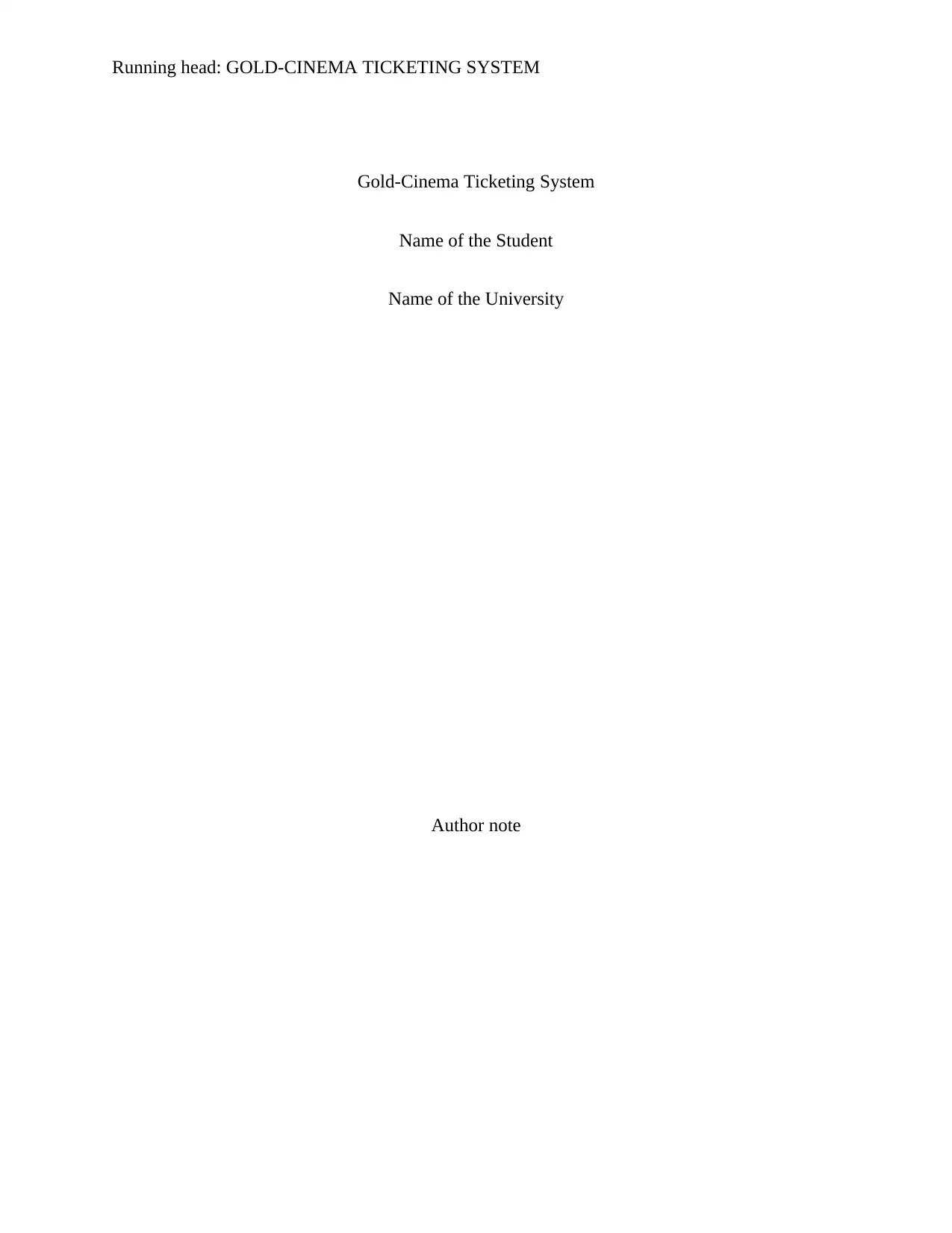
Running head: GOLD-CINEMA TICKETING SYSTEM
Gold-Cinema Ticketing System
Name of the Student
Name of the University
Author note
Gold-Cinema Ticketing System
Name of the Student
Name of the University
Author note
Paraphrase This Document
Need a fresh take? Get an instant paraphrase of this document with our AI Paraphraser
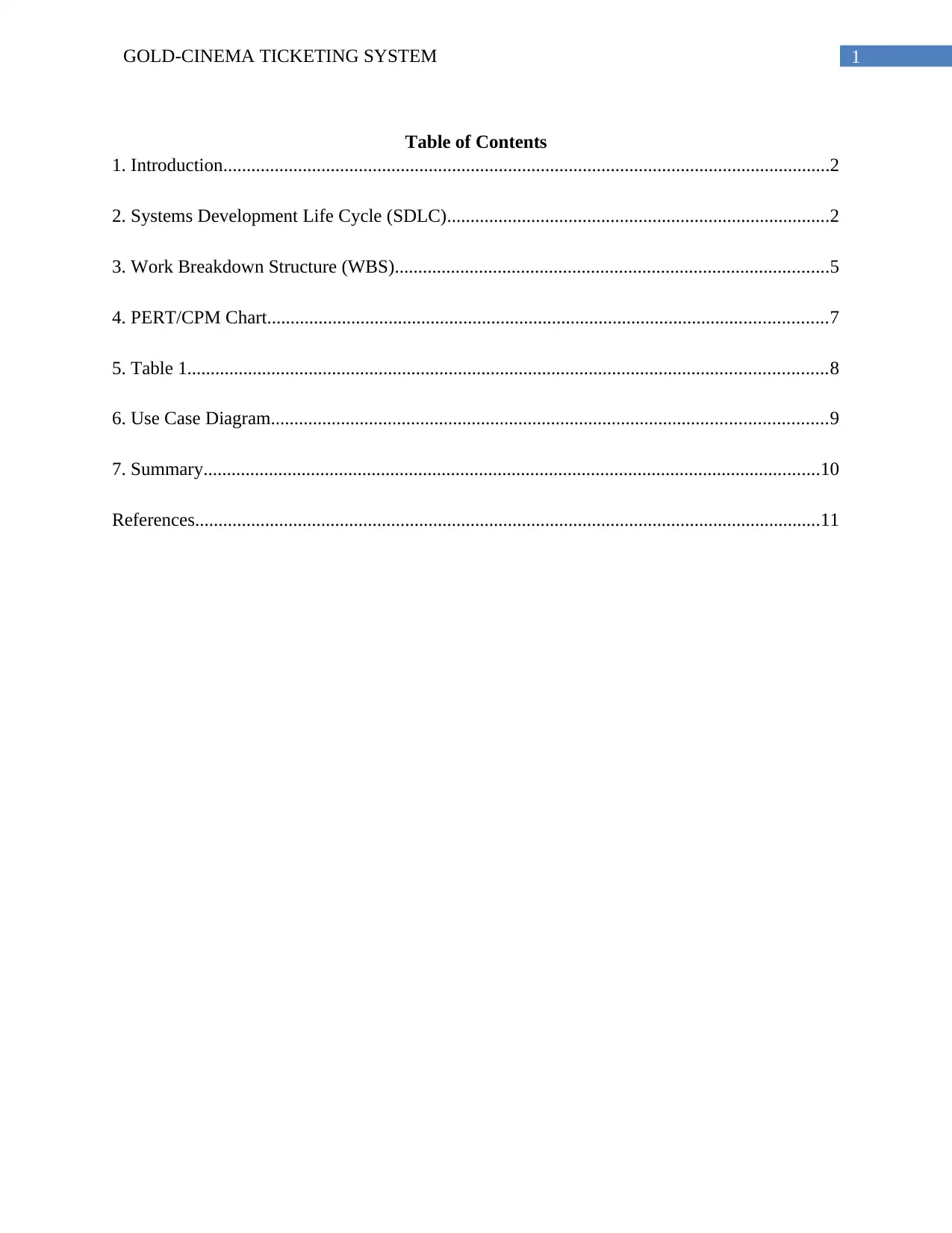
1GOLD-CINEMA TICKETING SYSTEM
Table of Contents
1. Introduction..................................................................................................................................2
2. Systems Development Life Cycle (SDLC)..................................................................................2
3. Work Breakdown Structure (WBS).............................................................................................5
4. PERT/CPM Chart........................................................................................................................7
5. Table 1.........................................................................................................................................8
6. Use Case Diagram.......................................................................................................................9
7. Summary....................................................................................................................................10
References......................................................................................................................................11
Table of Contents
1. Introduction..................................................................................................................................2
2. Systems Development Life Cycle (SDLC)..................................................................................2
3. Work Breakdown Structure (WBS).............................................................................................5
4. PERT/CPM Chart........................................................................................................................7
5. Table 1.........................................................................................................................................8
6. Use Case Diagram.......................................................................................................................9
7. Summary....................................................................................................................................10
References......................................................................................................................................11
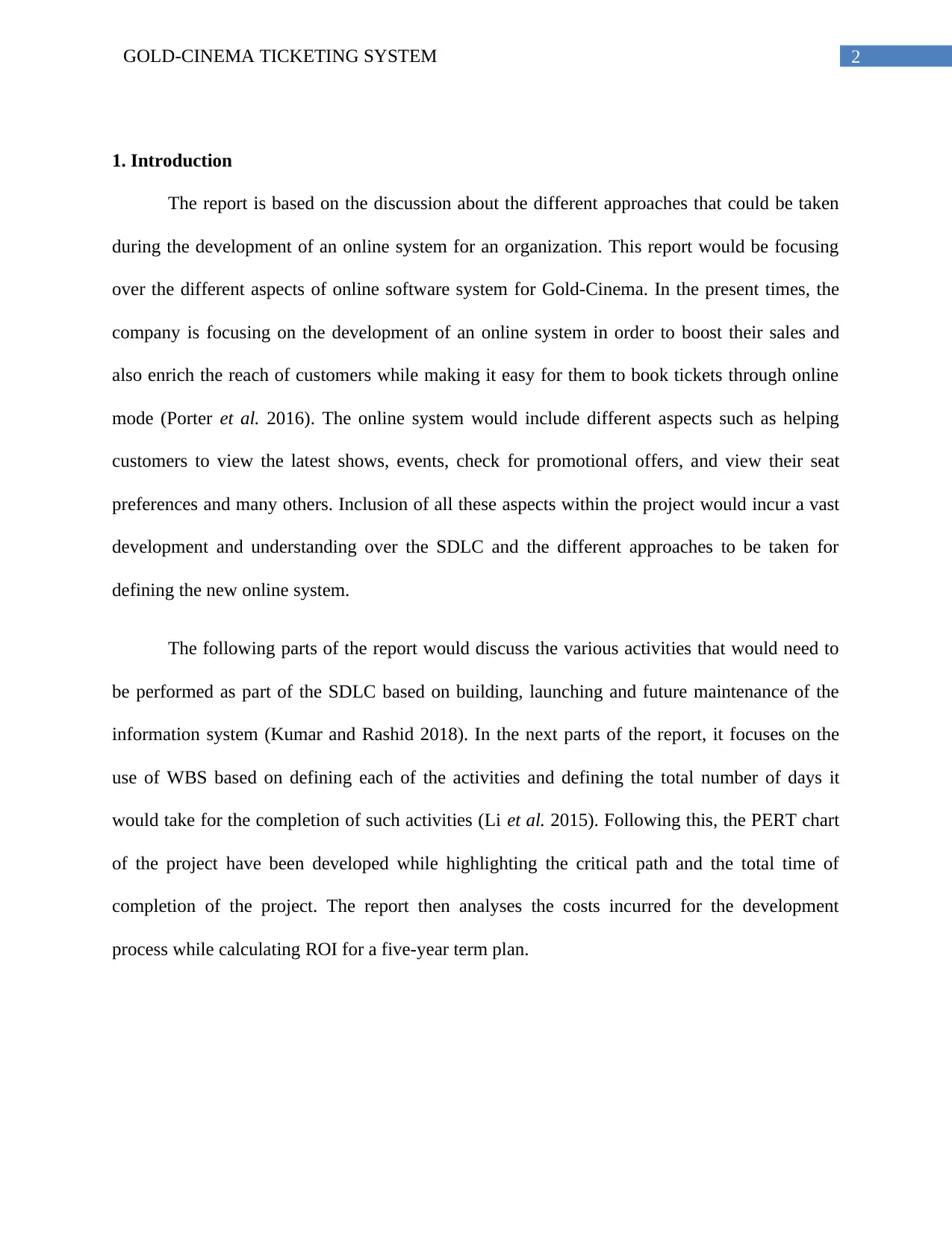
2GOLD-CINEMA TICKETING SYSTEM
1. Introduction
The report is based on the discussion about the different approaches that could be taken
during the development of an online system for an organization. This report would be focusing
over the different aspects of online software system for Gold-Cinema. In the present times, the
company is focusing on the development of an online system in order to boost their sales and
also enrich the reach of customers while making it easy for them to book tickets through online
mode (Porter et al. 2016). The online system would include different aspects such as helping
customers to view the latest shows, events, check for promotional offers, and view their seat
preferences and many others. Inclusion of all these aspects within the project would incur a vast
development and understanding over the SDLC and the different approaches to be taken for
defining the new online system.
The following parts of the report would discuss the various activities that would need to
be performed as part of the SDLC based on building, launching and future maintenance of the
information system (Kumar and Rashid 2018). In the next parts of the report, it focuses on the
use of WBS based on defining each of the activities and defining the total number of days it
would take for the completion of such activities (Li et al. 2015). Following this, the PERT chart
of the project have been developed while highlighting the critical path and the total time of
completion of the project. The report then analyses the costs incurred for the development
process while calculating ROI for a five-year term plan.
1. Introduction
The report is based on the discussion about the different approaches that could be taken
during the development of an online system for an organization. This report would be focusing
over the different aspects of online software system for Gold-Cinema. In the present times, the
company is focusing on the development of an online system in order to boost their sales and
also enrich the reach of customers while making it easy for them to book tickets through online
mode (Porter et al. 2016). The online system would include different aspects such as helping
customers to view the latest shows, events, check for promotional offers, and view their seat
preferences and many others. Inclusion of all these aspects within the project would incur a vast
development and understanding over the SDLC and the different approaches to be taken for
defining the new online system.
The following parts of the report would discuss the various activities that would need to
be performed as part of the SDLC based on building, launching and future maintenance of the
information system (Kumar and Rashid 2018). In the next parts of the report, it focuses on the
use of WBS based on defining each of the activities and defining the total number of days it
would take for the completion of such activities (Li et al. 2015). Following this, the PERT chart
of the project have been developed while highlighting the critical path and the total time of
completion of the project. The report then analyses the costs incurred for the development
process while calculating ROI for a five-year term plan.
⊘ This is a preview!⊘
Do you want full access?
Subscribe today to unlock all pages.

Trusted by 1+ million students worldwide
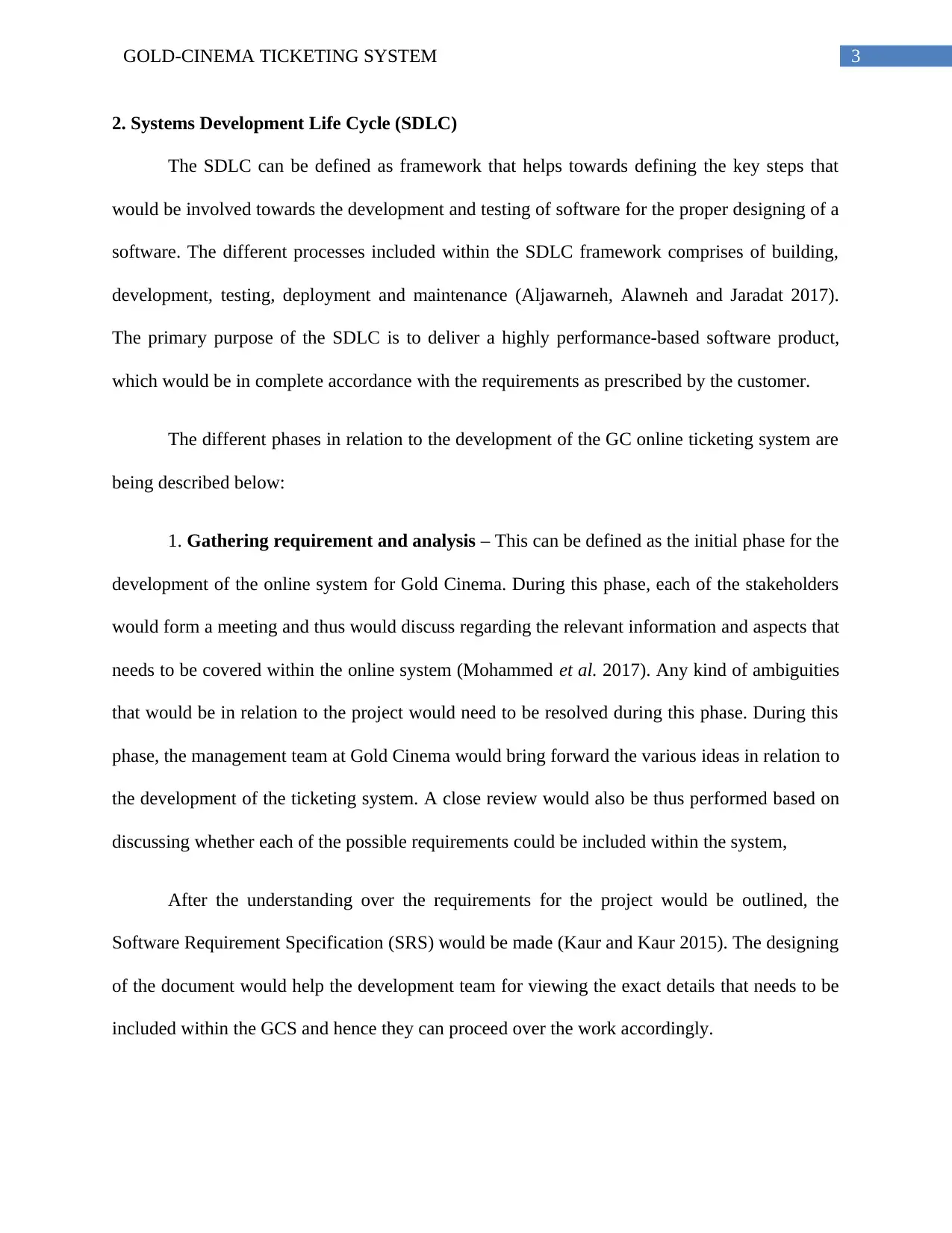
3GOLD-CINEMA TICKETING SYSTEM
2. Systems Development Life Cycle (SDLC)
The SDLC can be defined as framework that helps towards defining the key steps that
would be involved towards the development and testing of software for the proper designing of a
software. The different processes included within the SDLC framework comprises of building,
development, testing, deployment and maintenance (Aljawarneh, Alawneh and Jaradat 2017).
The primary purpose of the SDLC is to deliver a highly performance-based software product,
which would be in complete accordance with the requirements as prescribed by the customer.
The different phases in relation to the development of the GC online ticketing system are
being described below:
1. Gathering requirement and analysis – This can be defined as the initial phase for the
development of the online system for Gold Cinema. During this phase, each of the stakeholders
would form a meeting and thus would discuss regarding the relevant information and aspects that
needs to be covered within the online system (Mohammed et al. 2017). Any kind of ambiguities
that would be in relation to the project would need to be resolved during this phase. During this
phase, the management team at Gold Cinema would bring forward the various ideas in relation to
the development of the ticketing system. A close review would also be thus performed based on
discussing whether each of the possible requirements could be included within the system,
After the understanding over the requirements for the project would be outlined, the
Software Requirement Specification (SRS) would be made (Kaur and Kaur 2015). The designing
of the document would help the development team for viewing the exact details that needs to be
included within the GCS and hence they can proceed over the work accordingly.
2. Systems Development Life Cycle (SDLC)
The SDLC can be defined as framework that helps towards defining the key steps that
would be involved towards the development and testing of software for the proper designing of a
software. The different processes included within the SDLC framework comprises of building,
development, testing, deployment and maintenance (Aljawarneh, Alawneh and Jaradat 2017).
The primary purpose of the SDLC is to deliver a highly performance-based software product,
which would be in complete accordance with the requirements as prescribed by the customer.
The different phases in relation to the development of the GC online ticketing system are
being described below:
1. Gathering requirement and analysis – This can be defined as the initial phase for the
development of the online system for Gold Cinema. During this phase, each of the stakeholders
would form a meeting and thus would discuss regarding the relevant information and aspects that
needs to be covered within the online system (Mohammed et al. 2017). Any kind of ambiguities
that would be in relation to the project would need to be resolved during this phase. During this
phase, the management team at Gold Cinema would bring forward the various ideas in relation to
the development of the ticketing system. A close review would also be thus performed based on
discussing whether each of the possible requirements could be included within the system,
After the understanding over the requirements for the project would be outlined, the
Software Requirement Specification (SRS) would be made (Kaur and Kaur 2015). The designing
of the document would help the development team for viewing the exact details that needs to be
included within the GCS and hence they can proceed over the work accordingly.
Paraphrase This Document
Need a fresh take? Get an instant paraphrase of this document with our AI Paraphraser
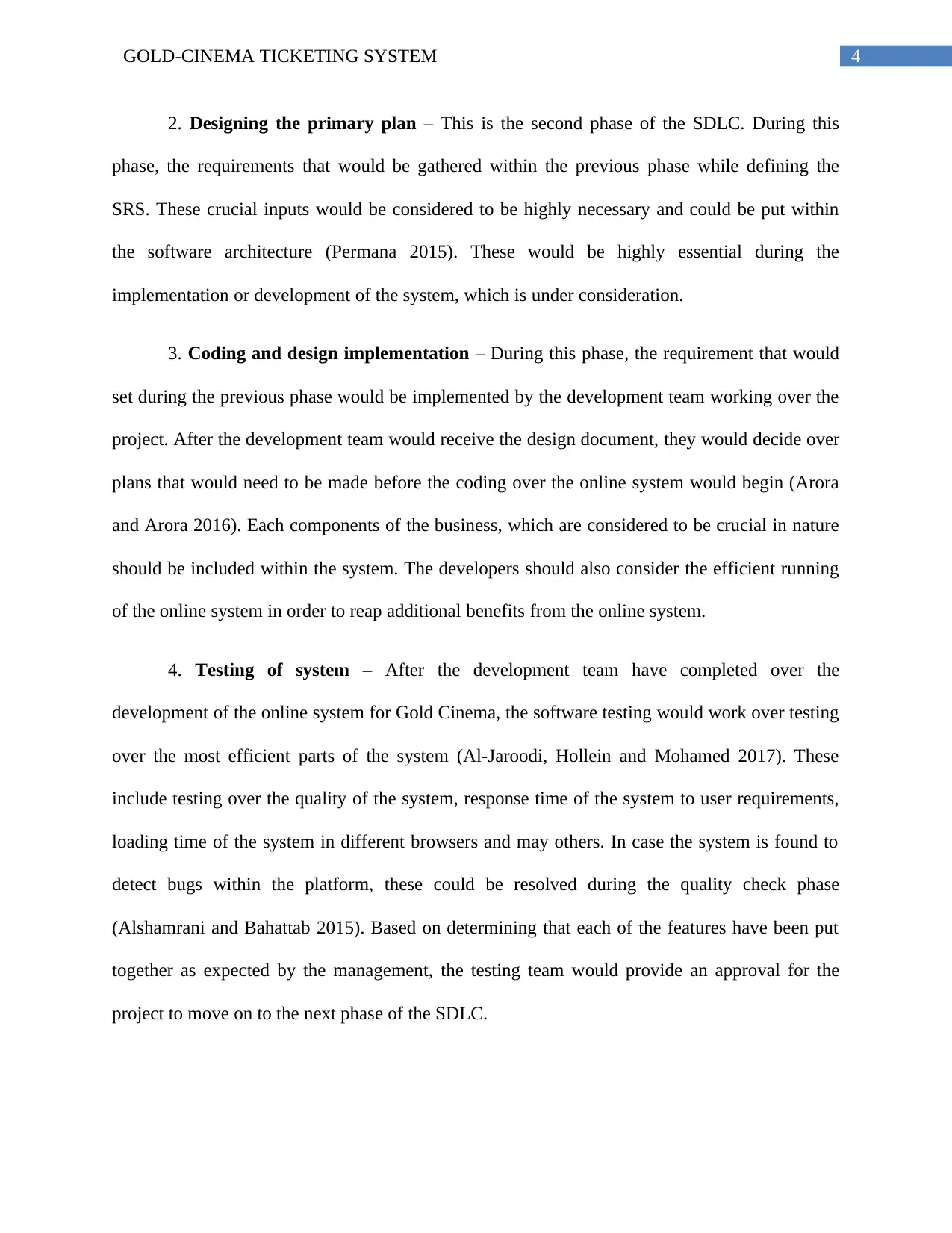
4GOLD-CINEMA TICKETING SYSTEM
2. Designing the primary plan – This is the second phase of the SDLC. During this
phase, the requirements that would be gathered within the previous phase while defining the
SRS. These crucial inputs would be considered to be highly necessary and could be put within
the software architecture (Permana 2015). These would be highly essential during the
implementation or development of the system, which is under consideration.
3. Coding and design implementation – During this phase, the requirement that would
set during the previous phase would be implemented by the development team working over the
project. After the development team would receive the design document, they would decide over
plans that would need to be made before the coding over the online system would begin (Arora
and Arora 2016). Each components of the business, which are considered to be crucial in nature
should be included within the system. The developers should also consider the efficient running
of the online system in order to reap additional benefits from the online system.
4. Testing of system – After the development team have completed over the
development of the online system for Gold Cinema, the software testing would work over testing
over the most efficient parts of the system (Al-Jaroodi, Hollein and Mohamed 2017). These
include testing over the quality of the system, response time of the system to user requirements,
loading time of the system in different browsers and may others. In case the system is found to
detect bugs within the platform, these could be resolved during the quality check phase
(Alshamrani and Bahattab 2015). Based on determining that each of the features have been put
together as expected by the management, the testing team would provide an approval for the
project to move on to the next phase of the SDLC.
2. Designing the primary plan – This is the second phase of the SDLC. During this
phase, the requirements that would be gathered within the previous phase while defining the
SRS. These crucial inputs would be considered to be highly necessary and could be put within
the software architecture (Permana 2015). These would be highly essential during the
implementation or development of the system, which is under consideration.
3. Coding and design implementation – During this phase, the requirement that would
set during the previous phase would be implemented by the development team working over the
project. After the development team would receive the design document, they would decide over
plans that would need to be made before the coding over the online system would begin (Arora
and Arora 2016). Each components of the business, which are considered to be crucial in nature
should be included within the system. The developers should also consider the efficient running
of the online system in order to reap additional benefits from the online system.
4. Testing of system – After the development team have completed over the
development of the online system for Gold Cinema, the software testing would work over testing
over the most efficient parts of the system (Al-Jaroodi, Hollein and Mohamed 2017). These
include testing over the quality of the system, response time of the system to user requirements,
loading time of the system in different browsers and may others. In case the system is found to
detect bugs within the platform, these could be resolved during the quality check phase
(Alshamrani and Bahattab 2015). Based on determining that each of the features have been put
together as expected by the management, the testing team would provide an approval for the
project to move on to the next phase of the SDLC.
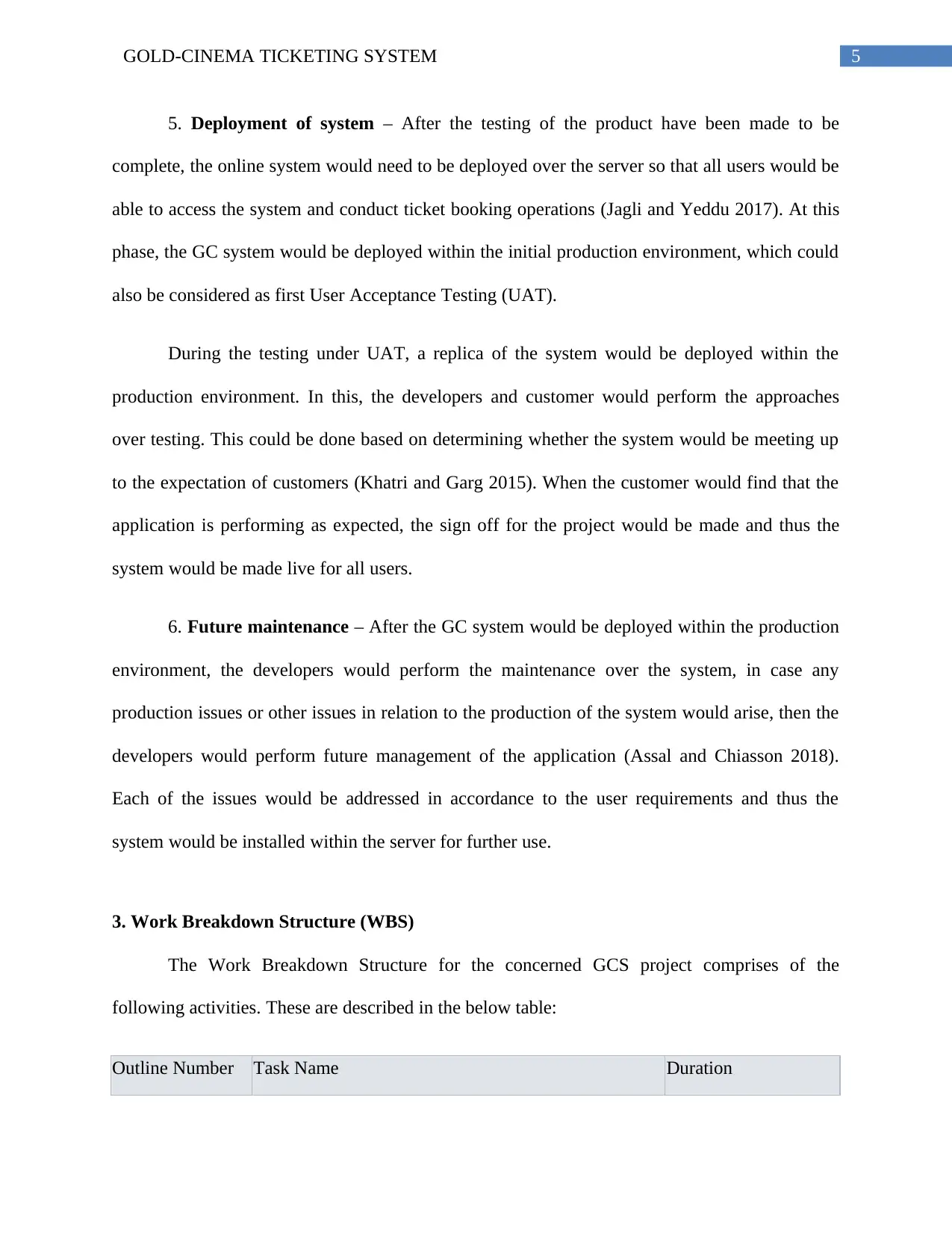
5GOLD-CINEMA TICKETING SYSTEM
5. Deployment of system – After the testing of the product have been made to be
complete, the online system would need to be deployed over the server so that all users would be
able to access the system and conduct ticket booking operations (Jagli and Yeddu 2017). At this
phase, the GC system would be deployed within the initial production environment, which could
also be considered as first User Acceptance Testing (UAT).
During the testing under UAT, a replica of the system would be deployed within the
production environment. In this, the developers and customer would perform the approaches
over testing. This could be done based on determining whether the system would be meeting up
to the expectation of customers (Khatri and Garg 2015). When the customer would find that the
application is performing as expected, the sign off for the project would be made and thus the
system would be made live for all users.
6. Future maintenance – After the GC system would be deployed within the production
environment, the developers would perform the maintenance over the system, in case any
production issues or other issues in relation to the production of the system would arise, then the
developers would perform future management of the application (Assal and Chiasson 2018).
Each of the issues would be addressed in accordance to the user requirements and thus the
system would be installed within the server for further use.
3. Work Breakdown Structure (WBS)
The Work Breakdown Structure for the concerned GCS project comprises of the
following activities. These are described in the below table:
Outline Number Task Name Duration
5. Deployment of system – After the testing of the product have been made to be
complete, the online system would need to be deployed over the server so that all users would be
able to access the system and conduct ticket booking operations (Jagli and Yeddu 2017). At this
phase, the GC system would be deployed within the initial production environment, which could
also be considered as first User Acceptance Testing (UAT).
During the testing under UAT, a replica of the system would be deployed within the
production environment. In this, the developers and customer would perform the approaches
over testing. This could be done based on determining whether the system would be meeting up
to the expectation of customers (Khatri and Garg 2015). When the customer would find that the
application is performing as expected, the sign off for the project would be made and thus the
system would be made live for all users.
6. Future maintenance – After the GC system would be deployed within the production
environment, the developers would perform the maintenance over the system, in case any
production issues or other issues in relation to the production of the system would arise, then the
developers would perform future management of the application (Assal and Chiasson 2018).
Each of the issues would be addressed in accordance to the user requirements and thus the
system would be installed within the server for further use.
3. Work Breakdown Structure (WBS)
The Work Breakdown Structure for the concerned GCS project comprises of the
following activities. These are described in the below table:
Outline Number Task Name Duration
⊘ This is a preview!⊘
Do you want full access?
Subscribe today to unlock all pages.

Trusted by 1+ million students worldwide

6GOLD-CINEMA TICKETING SYSTEM
0 Development of Online GCS System 83 days
1 Initial meeting and discussion 7 days
1.1 Identification of the need of online GCS 2 days
1.2 Preparing an initial draft plan 5 days
1.3 Waiting for approval of plan 0 days
2 Procurement of systems and resources 15 days
2.1 Preparing a procurement plan 1 day
2.2 Waiting for approval of procurement plan 0 days
2.3 Procurement of system resources 1 day
2.4 Checking over the procured items 0 days
2.5 Hiring of software development technicians 15 days
3 Development of the system 21 days
3.1 Preparing an initial technical plan 1 day
3.2 Approval over plan 0 days
3.3 Development of the online system 20 days
3.4 Detailing plans and network support 9 days
4 System testing and quality check 36 days
4.1 Initial system test and quality check 25 days
4.2 Approval of system 0 days
4.3 Installation of system in ticketing office 6 days
4.4 Making the system live to users 5 days
5 Project closure 4 days
As per the discussion in the above described WBS, it can be seen that there are five
primary phases within the development of the GCS system. In the initial phase, a meeting would
0 Development of Online GCS System 83 days
1 Initial meeting and discussion 7 days
1.1 Identification of the need of online GCS 2 days
1.2 Preparing an initial draft plan 5 days
1.3 Waiting for approval of plan 0 days
2 Procurement of systems and resources 15 days
2.1 Preparing a procurement plan 1 day
2.2 Waiting for approval of procurement plan 0 days
2.3 Procurement of system resources 1 day
2.4 Checking over the procured items 0 days
2.5 Hiring of software development technicians 15 days
3 Development of the system 21 days
3.1 Preparing an initial technical plan 1 day
3.2 Approval over plan 0 days
3.3 Development of the online system 20 days
3.4 Detailing plans and network support 9 days
4 System testing and quality check 36 days
4.1 Initial system test and quality check 25 days
4.2 Approval of system 0 days
4.3 Installation of system in ticketing office 6 days
4.4 Making the system live to users 5 days
5 Project closure 4 days
As per the discussion in the above described WBS, it can be seen that there are five
primary phases within the development of the GCS system. In the initial phase, a meeting would
Paraphrase This Document
Need a fresh take? Get an instant paraphrase of this document with our AI Paraphraser

7GOLD-CINEMA TICKETING SYSTEM
be formed in which the primary requirements of the system would be considered (Khari and
Kumar 2016). In this discussion, various aspects would be discussed regarding the benefits and
future outcomes from the project. After a discussion over the initial requirements, the
procurement of the essential aspects in relation to the project would be determined and procured
accordingly (Karim et al. 2016). After each of the necessary aspects have been procured and the
technician team have been hired, the development plan would be designed in the next phase.
After the plan have been developed, the development team would start the work over the project.
The coding of the system would be done in such a manner that every needed aspect would be
developed accordingly.
After the system have been developed, the testing of the system would be made. Any
kind of bugs within the system or improvements that would be required would be made
accordingly to the needs of the customers. The system would be checked and each of the quality
aspects would be determined accordingly (Shongwe 2016). After the system check have been
performed, the documentation of the system would be performed accordingly and thus the
system would be made live for access to all users of the Gold Cinema.
4. PERT/CPM Chart
(Figure 1: The PERT/CPM Chart for the GCS Project)
be formed in which the primary requirements of the system would be considered (Khari and
Kumar 2016). In this discussion, various aspects would be discussed regarding the benefits and
future outcomes from the project. After a discussion over the initial requirements, the
procurement of the essential aspects in relation to the project would be determined and procured
accordingly (Karim et al. 2016). After each of the necessary aspects have been procured and the
technician team have been hired, the development plan would be designed in the next phase.
After the plan have been developed, the development team would start the work over the project.
The coding of the system would be done in such a manner that every needed aspect would be
developed accordingly.
After the system have been developed, the testing of the system would be made. Any
kind of bugs within the system or improvements that would be required would be made
accordingly to the needs of the customers. The system would be checked and each of the quality
aspects would be determined accordingly (Shongwe 2016). After the system check have been
performed, the documentation of the system would be performed accordingly and thus the
system would be made live for access to all users of the Gold Cinema.
4. PERT/CPM Chart
(Figure 1: The PERT/CPM Chart for the GCS Project)
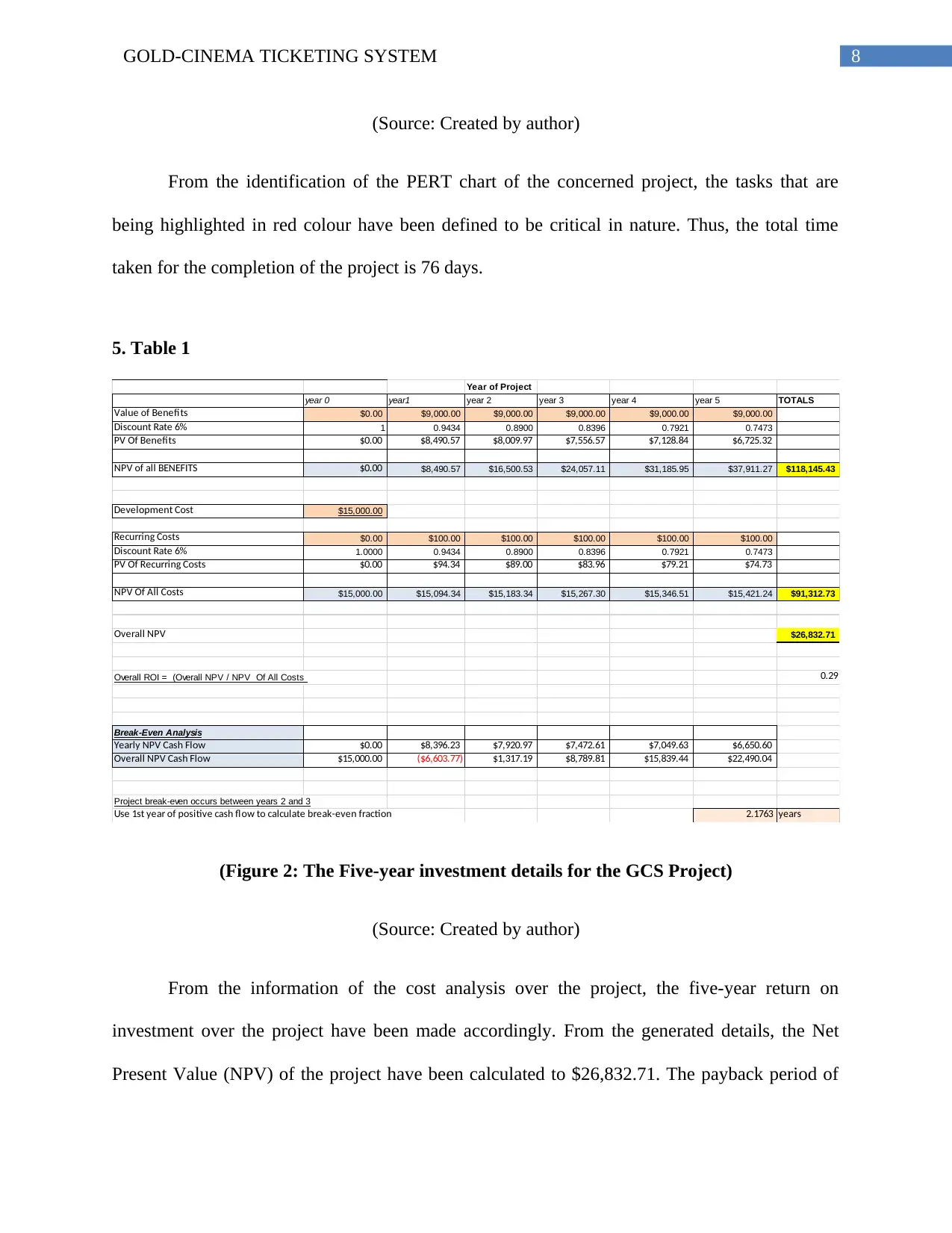
8GOLD-CINEMA TICKETING SYSTEM
(Source: Created by author)
From the identification of the PERT chart of the concerned project, the tasks that are
being highlighted in red colour have been defined to be critical in nature. Thus, the total time
taken for the completion of the project is 76 days.
5. Table 1
Year of Project
year 0 year1 year 2 year 3 year 4 year 5 TOTALS
Value of Benefits $0.00 $9,000.00 $9,000.00 $9,000.00 $9,000.00 $9,000.00
Discount Rate 6% 1 0.9434 0.8900 0.8396 0.7921 0.7473
PV Of Benefits $0.00 $8,490.57 $8,009.97 $7,556.57 $7,128.84 $6,725.32
NPV of all BENEFITS $0.00 $8,490.57 $16,500.53 $24,057.11 $31,185.95 $37,911.27 $118,145.43
Development Cost $15,000.00
Recurring Costs $0.00 $100.00 $100.00 $100.00 $100.00 $100.00
Discount Rate 6% 1.0000 0.9434 0.8900 0.8396 0.7921 0.7473
PV Of Recurring Costs $0.00 $94.34 $89.00 $83.96 $79.21 $74.73
NPV Of All Costs $15,000.00 $15,094.34 $15,183.34 $15,267.30 $15,346.51 $15,421.24 $91,312.73
Overall NPV $26,832.71
Overall ROI = (Overall NPV / NPV Of All Costs 0.29
Break-Even Analysis
Yearly NPV Cash Flow $0.00 $8,396.23 $7,920.97 $7,472.61 $7,049.63 $6,650.60
Overall NPV Cash Flow $15,000.00 ($6,603.77) $1,317.19 $8,789.81 $15,839.44 $22,490.04
Project break-even occurs between years 2 and 3
Use 1st year of positive cash flow to calculate break-even fraction 2.1763 years
(Figure 2: The Five-year investment details for the GCS Project)
(Source: Created by author)
From the information of the cost analysis over the project, the five-year return on
investment over the project have been made accordingly. From the generated details, the Net
Present Value (NPV) of the project have been calculated to $26,832.71. The payback period of
(Source: Created by author)
From the identification of the PERT chart of the concerned project, the tasks that are
being highlighted in red colour have been defined to be critical in nature. Thus, the total time
taken for the completion of the project is 76 days.
5. Table 1
Year of Project
year 0 year1 year 2 year 3 year 4 year 5 TOTALS
Value of Benefits $0.00 $9,000.00 $9,000.00 $9,000.00 $9,000.00 $9,000.00
Discount Rate 6% 1 0.9434 0.8900 0.8396 0.7921 0.7473
PV Of Benefits $0.00 $8,490.57 $8,009.97 $7,556.57 $7,128.84 $6,725.32
NPV of all BENEFITS $0.00 $8,490.57 $16,500.53 $24,057.11 $31,185.95 $37,911.27 $118,145.43
Development Cost $15,000.00
Recurring Costs $0.00 $100.00 $100.00 $100.00 $100.00 $100.00
Discount Rate 6% 1.0000 0.9434 0.8900 0.8396 0.7921 0.7473
PV Of Recurring Costs $0.00 $94.34 $89.00 $83.96 $79.21 $74.73
NPV Of All Costs $15,000.00 $15,094.34 $15,183.34 $15,267.30 $15,346.51 $15,421.24 $91,312.73
Overall NPV $26,832.71
Overall ROI = (Overall NPV / NPV Of All Costs 0.29
Break-Even Analysis
Yearly NPV Cash Flow $0.00 $8,396.23 $7,920.97 $7,472.61 $7,049.63 $6,650.60
Overall NPV Cash Flow $15,000.00 ($6,603.77) $1,317.19 $8,789.81 $15,839.44 $22,490.04
Project break-even occurs between years 2 and 3
Use 1st year of positive cash flow to calculate break-even fraction 2.1763 years
(Figure 2: The Five-year investment details for the GCS Project)
(Source: Created by author)
From the information of the cost analysis over the project, the five-year return on
investment over the project have been made accordingly. From the generated details, the Net
Present Value (NPV) of the project have been calculated to $26,832.71. The payback period of
⊘ This is a preview!⊘
Do you want full access?
Subscribe today to unlock all pages.

Trusted by 1+ million students worldwide
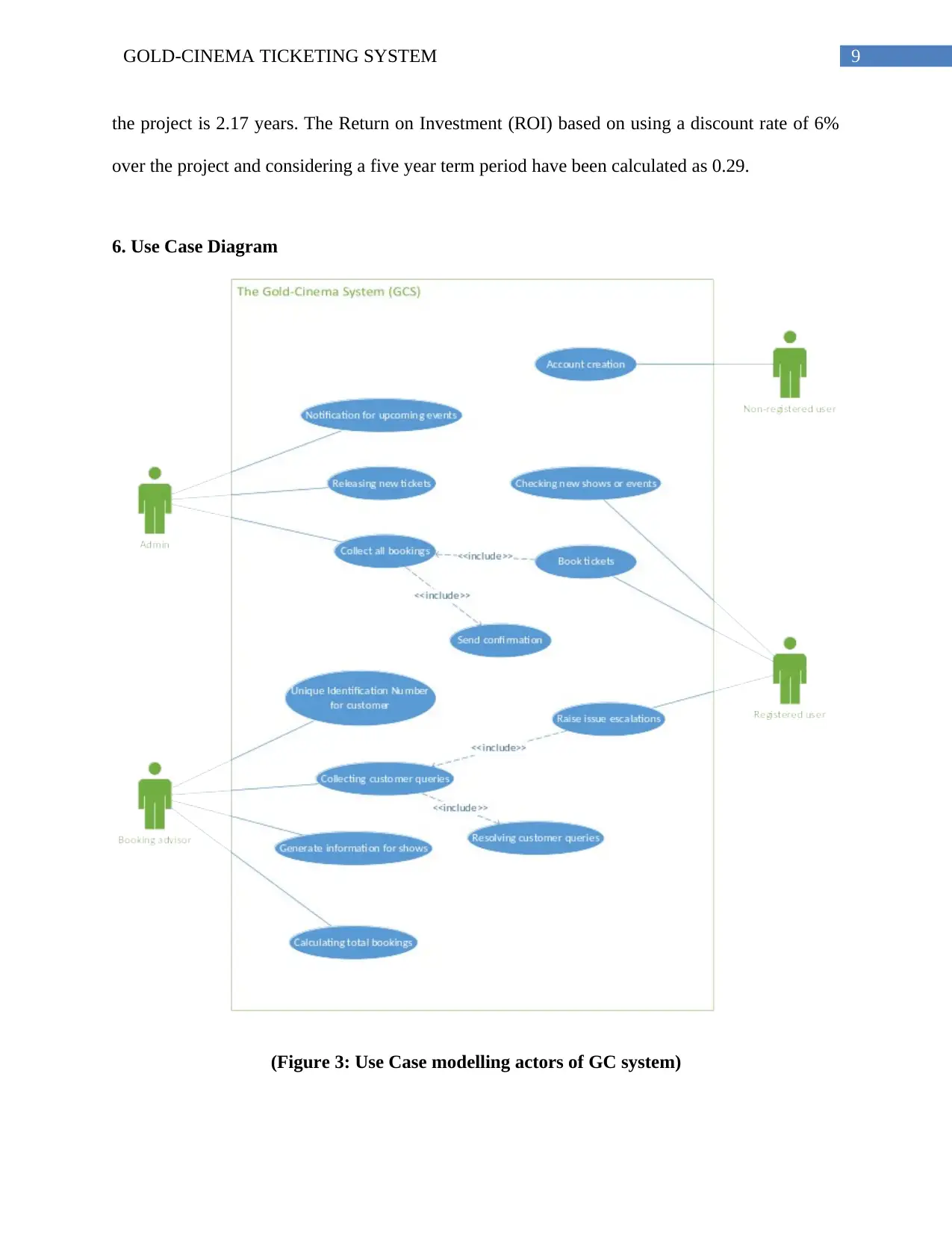
9GOLD-CINEMA TICKETING SYSTEM
the project is 2.17 years. The Return on Investment (ROI) based on using a discount rate of 6%
over the project and considering a five year term period have been calculated as 0.29.
6. Use Case Diagram
(Figure 3: Use Case modelling actors of GC system)
the project is 2.17 years. The Return on Investment (ROI) based on using a discount rate of 6%
over the project and considering a five year term period have been calculated as 0.29.
6. Use Case Diagram
(Figure 3: Use Case modelling actors of GC system)
Paraphrase This Document
Need a fresh take? Get an instant paraphrase of this document with our AI Paraphraser
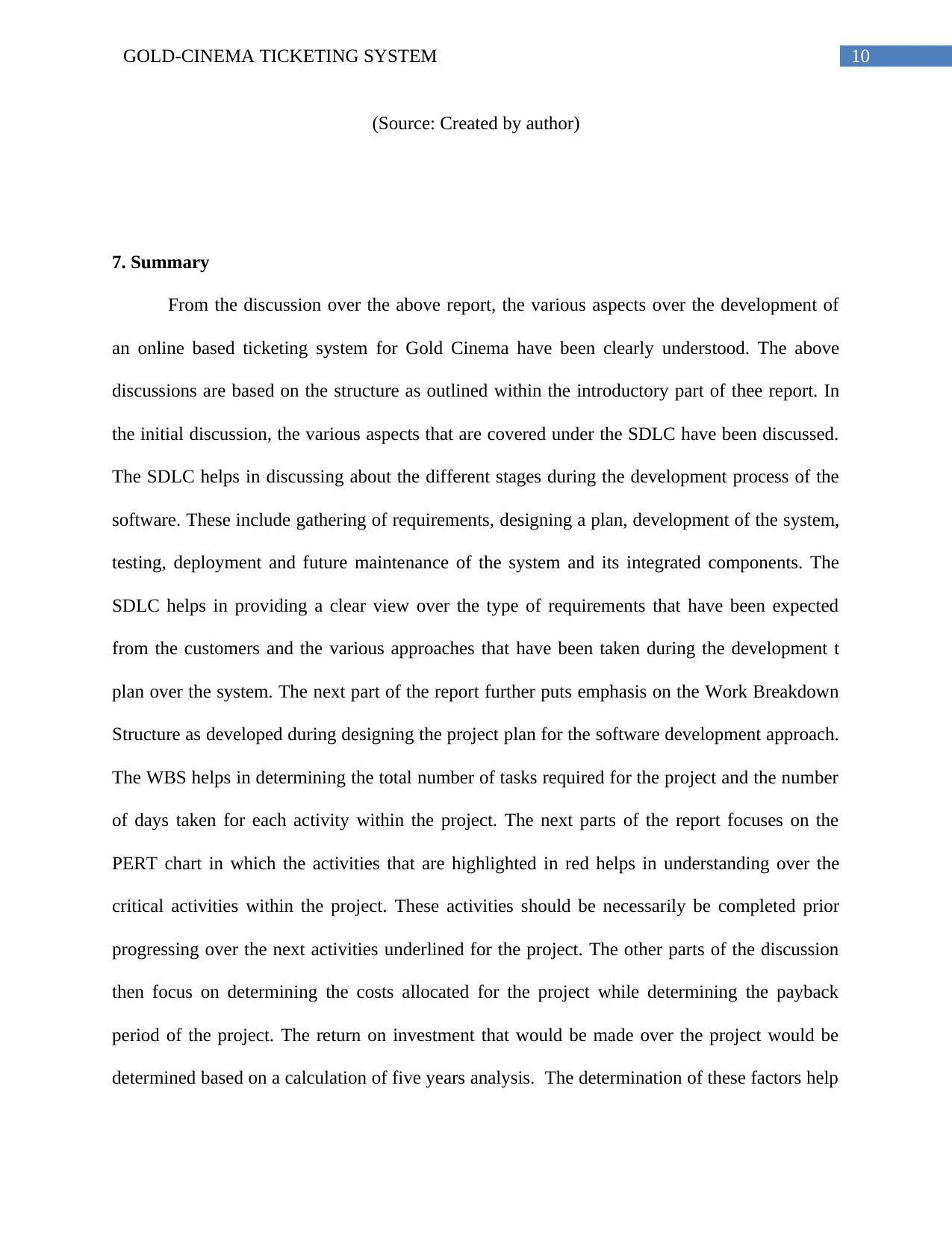
10GOLD-CINEMA TICKETING SYSTEM
(Source: Created by author)
7. Summary
From the discussion over the above report, the various aspects over the development of
an online based ticketing system for Gold Cinema have been clearly understood. The above
discussions are based on the structure as outlined within the introductory part of thee report. In
the initial discussion, the various aspects that are covered under the SDLC have been discussed.
The SDLC helps in discussing about the different stages during the development process of the
software. These include gathering of requirements, designing a plan, development of the system,
testing, deployment and future maintenance of the system and its integrated components. The
SDLC helps in providing a clear view over the type of requirements that have been expected
from the customers and the various approaches that have been taken during the development t
plan over the system. The next part of the report further puts emphasis on the Work Breakdown
Structure as developed during designing the project plan for the software development approach.
The WBS helps in determining the total number of tasks required for the project and the number
of days taken for each activity within the project. The next parts of the report focuses on the
PERT chart in which the activities that are highlighted in red helps in understanding over the
critical activities within the project. These activities should be necessarily be completed prior
progressing over the next activities underlined for the project. The other parts of the discussion
then focus on determining the costs allocated for the project while determining the payback
period of the project. The return on investment that would be made over the project would be
determined based on a calculation of five years analysis. The determination of these factors help
(Source: Created by author)
7. Summary
From the discussion over the above report, the various aspects over the development of
an online based ticketing system for Gold Cinema have been clearly understood. The above
discussions are based on the structure as outlined within the introductory part of thee report. In
the initial discussion, the various aspects that are covered under the SDLC have been discussed.
The SDLC helps in discussing about the different stages during the development process of the
software. These include gathering of requirements, designing a plan, development of the system,
testing, deployment and future maintenance of the system and its integrated components. The
SDLC helps in providing a clear view over the type of requirements that have been expected
from the customers and the various approaches that have been taken during the development t
plan over the system. The next part of the report further puts emphasis on the Work Breakdown
Structure as developed during designing the project plan for the software development approach.
The WBS helps in determining the total number of tasks required for the project and the number
of days taken for each activity within the project. The next parts of the report focuses on the
PERT chart in which the activities that are highlighted in red helps in understanding over the
critical activities within the project. These activities should be necessarily be completed prior
progressing over the next activities underlined for the project. The other parts of the discussion
then focus on determining the costs allocated for the project while determining the payback
period of the project. The return on investment that would be made over the project would be
determined based on a calculation of five years analysis. The determination of these factors help

11GOLD-CINEMA TICKETING SYSTEM
in determining that the project could be designed successfully, which would in turn lead to
beneficial return for the business.
in determining that the project could be designed successfully, which would in turn lead to
beneficial return for the business.
⊘ This is a preview!⊘
Do you want full access?
Subscribe today to unlock all pages.

Trusted by 1+ million students worldwide
1 out of 15
Related Documents
Your All-in-One AI-Powered Toolkit for Academic Success.
+13062052269
info@desklib.com
Available 24*7 on WhatsApp / Email
![[object Object]](/_next/static/media/star-bottom.7253800d.svg)
Unlock your academic potential
Copyright © 2020–2025 A2Z Services. All Rights Reserved. Developed and managed by ZUCOL.





